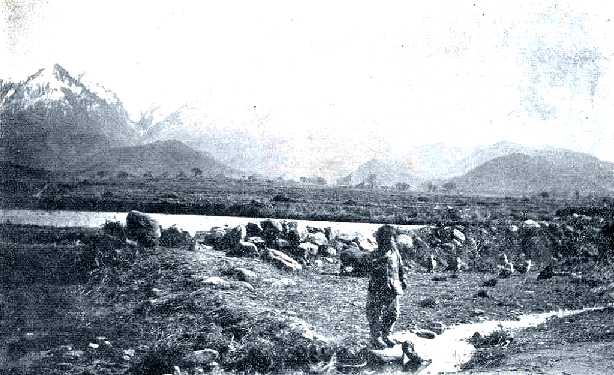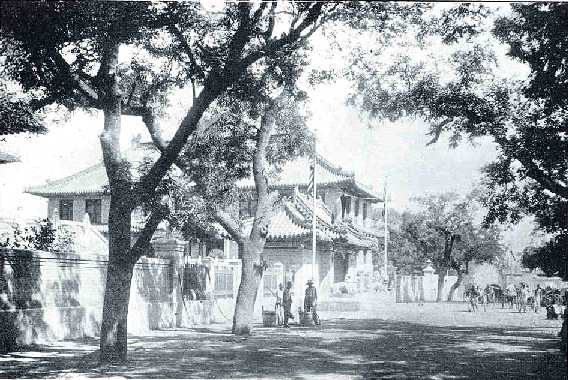Francis Gamewell was born in Camden, South Carolina on August 31,
1857. His father, John Gamewell, was an inventor. His most
famous accomplishments include the Gamewell Fire Alarm and the Police Telegraph.1
As a young child Frank was profoundly influenced by his family's close
involvement with the Methodist Episcopal Church.2
Coincidentally, Gamewell's uncle, Dr. Charles Taylor, was the first
medical missionary sent to China through the Methodist Episcopal Church.3
As southern sentiment for a war between the states started to increase,
John decided to move his family to Hackensack, New Jersey. At the
age of eighteen, Frank matriculated to Reneseleer
Polytechnical Institute (R.P.I.), unfortunately his undergraduate career
was interrupted by a serious accident. When he returned to school, he decided
to make the move to upstate New York and attend Cornell University.
In a strange twist of fate, Gamewell again had his school year interrupted
by misfortune. He contracted a severe illness and was unable to attend
classes for several weeks. After he recuperated, Frank decided that
his current path was not the calling God had intended for him.4
With his family roots in mind, he matriculated to Dickinson College
in 1877; which was, at that time, affiliated with the Methodist church.
Under the advice of several clergy and professors, Gamewell made his decision
to become missionary and, subsequently, put his fate in the hands of the
Foreign Missionary Society of the Methodist Church.5
In October, 1881, Rev. Frank D. Gamewell arrived in Peking, China. He soon met his future wife, also a missionary, and in December they were married. Fortunately, Mrs. Gamewell recorded her life, as an agent of the church, in her diaries which were later compiled into a volume entitled Mary Porter Gamewell and her story of the siege in Peking. This work is an excellent reference to turn of the century Missionary life in China. In 1884, the Gamewells started their first collective missionary in Chungking. Mary described it: "Our West China Mission has its present home in a 'well,' or a series of wells. The buildings which unite to form these walls are fine buildings; they are well built; they are supported by many expensive pillars of wood...."6 After searching two years for a site, in March of 1886 they began expanding the mission by building a hospital, a girls' school, and several mission homes. Mary was a missionary in the traditional sense of the word. She was most likely to be seen at the local Sunday school spreading the gospel and teaching young Chinese girls how to read.7Mr. Gamewell, on the other hand, was appointed superintendent of the West China Mission and, in this capacity, he supervised the construction of most of the buildings. His portfolio includes the erection of the largest Protestant ecclesiastical structure in China. It held 1500 people and was by far the most auspicious structure of the Methodist compound.8
Dickinson-in-China, 1921-27; Archives and Special Collections, Dickinson College, Carlisle, Pa.
While they made progress physically in the erection of buildings and the expansion of the compound itself, the Gamewells faced adversity at every turn, especially with the almost constant threat of riots. Mrs. Gamewell describes many instances in her diary when she was not sure if Mr. Gamewell would make it home in time to quell the rebellions gathered in front of their home. At one time she even took Frank's gun, although unloaded, in an attempt to scare away the natives.9 The Gamewells knowledge of local customs was quite limited, and they often inadvertently offended their neighbors:
This instinctive hostility to the foreigner becomes almost a religious frenzy among the unreasoning masses, when it is fired by popular superstitions. The foreigner erects buildings above a given elevation, and thus obstructs the flight of irritable spirits and excites their rage against a helpless people. The baptism of dying infants is a part of a devilish science by which certain parts of the human body may be put to the transmutation of metals. The erection of orphanages is for this same fiendish alchemy.10As was typical of other missionaries, after ten years of missionary work, the Gamewells returned to America. During this break from missionary life, Frank studied Physics at Columbia and received his doctorate there. When the Gamewells returned to China, Frank began his career as a professor at Peking University.

Dickinson-in-China, 1921-27;
Archives and Special Collections, Dickinson College, Carlisle, Pa.
(click
for larger version of this photograph)
While staying in Peking, the Gamewells found themselves once again embroiled in a series of riots. Unfortunately, as time progressed, the rioting evolved into what is now known as the Boxer Rebellion. Frank's architectural experience was well known around the city and the mayor soon called upon him to supervise the fortifications for Peking:11
Mr. Gamewell had, early in the progress of affairs, called masons and built solid brick work over the outside of all gates in our walls that could be dispensed with, thus providing against their being fired by the Boxers, who were daily assuming a more threatening attitude in the city. He also had barbed wire stretched across the courts to prevent a rush of the enemy in case they should break into our premises. After the coming of the soldiers the work of fortifying went well.12The Boxer Uprising took its toll upon the city, as well as on the Gamewells. Mary's sustained bout with illness had brought her to a breaking point. The Boxers invaded the city immediately before Mrs. Gamewell planned to leave for America to receive medical treatment. On August 22, 1900, she left China, never to return. Mr. Gamewell was appointed by the Missionary Board of the Methodist Episcopal Church as Field Secretary of the Open Door Commission. Unfortunately, the events following his appointment remain unknown. In 1906, Mary died, leaving behind a tale of woe about a journey to a foreign land and its native customs. For her, the culture proved to be too entrenched in pagan rituals to readily accept the Christian ideals that men and women from places like Dickinson College sought to bestow.
[top]
2. Gamewell, Mary Porter. Mary Porter Gamewell and her story of the siege in Peking. Ed A.H. Tuttle. New York: Eaton & Mains; Cincinnati: Jennings & Graham, 1907. pg 99.
3.Gamewell, Mary Porter. Mary Porter Gamewell and her story of the siege in Peking. Ed A.H. Tuttle. New York: Eaton & Mains; Cincinnati: Jennings & Graham, 1907. pg 99.
4.Gamewell, Mary Porter. Mary Porter Gamewell and her story of the siege in Peking. Ed A.H. Tuttle. New York: Eaton & Mains; Cincinnati: Jennings & Graham, 1907. pg 100.
5. News clipping source unknown, Oct. 1881. Drop File: Gamewell, Francis Dunlap; Archives and Special Collections, Dickinson College, Carlisle, Pa.
6. Gamewell, Mary Porter. Mary Porter Gamewell and her story of the siege in Peking. Ed A.H. Tuttle. New York: Eaton & Mains; Cincinnati: Jennings & Graham, 1907. pg 114.
7. Gamewell, Mary Porter. Mary Porter Gamewell and her story of the siege in Peking. Ed A.H. Tuttle. New York: Eaton & Mains; Cincinnati: Jennings & Graham, 1907. pg 105.
8. Gamewell, Mary Porter. Mary Porter Gamewell and her story of the siege in Peking. Ed A.H. Tuttle. New York: Eaton & Mains; Cincinnati: Jennings & Graham, 1907. pg 151.
9. Gamewell, Mary Porter. Mary Porter Gamewell and her story of the siege in Peking. Ed A.H. Tuttle. New York: Eaton & Mains; Cincinnati: Jennings & Graham, 1907. pg 125.
10. Gamewell, Mary Porter. Mary Porter Gamewell and her story of the siege in Peking. Ed A.H. Tuttle. New York: Eaton & Mains; Cincinnati: Jennings & Graham, 1907. pg 129.
11.Gamewell, Mary Porter. Mary Porter Gamewell and her story of the siege in Peking. Ed A.H. Tuttle. New York: Eaton & Mains; Cincinnati: Jennings & Graham, 1907. pg 284.
12. Gamewell, Mary Porter. Mary Porter Gamewell and her story of the siege in Peking. Ed A.H. Tuttle. New York: Eaton & Mains; Cincinnati: Jennings & Graham, 1907. pg 190.
**For more information regarding the Gamewells' Mission visit the Dickinson College Archives and Special Collections, Dickinson College, Carlisle, Pa.